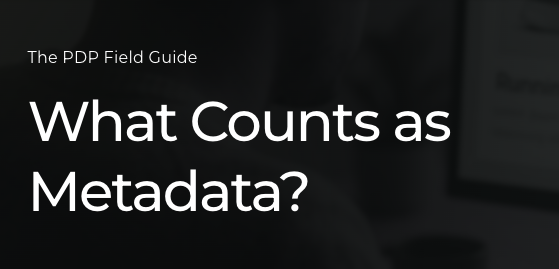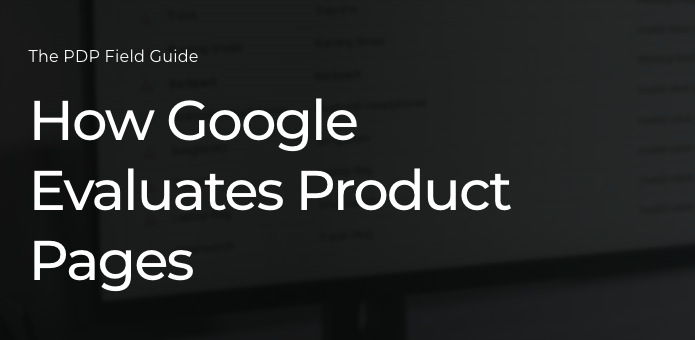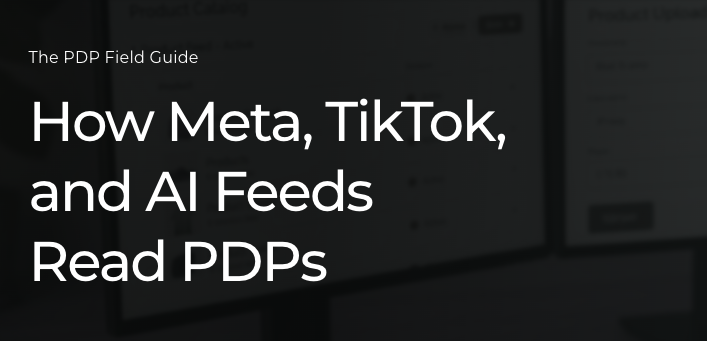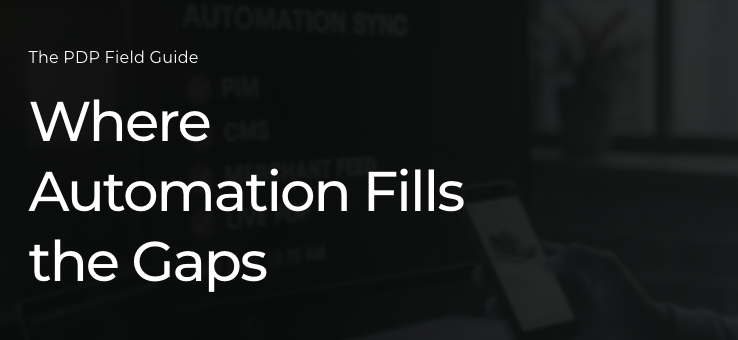✨ Interactive Learning Platform
Master ecommerce product data
Explore lessons, guides, terms, and categories that drive real business results.
.png)

Product Data Courses
View all courses →
The PDP Field Guide
Master‑class on building, governing and refreshing product pages for AI‑led discovery.
Reference Guide
View full glossary →Bulk Update API
Endpoint for mass‑editing PDP fields programmatically.
PDP Scalability
The ability to scale PDP creation and management efficiently.
Field Standardization
Making PDP fields uniform across systems.
Catalog Hygiene
Maintaining clean and accurate product data.
SEO Debt
Accumulated PDP issues from outdated SEO.
Multi Brand Ops
Running PDP governance across multiple brands.
PDP SEO Pitfalls
Common SEO mistakes on product detail pages.
Duplicate Content
Copy/paste product descriptions across PDPs.
PDP Drift
Slow misalignment of PDP content from source data.
Content Expiration
When PDP content becomes outdated.
Update Cadence
Frequency of structured PDP updates.
PDP Refresh
Regularly updating PDP content and schema.
Cross Platform Checks
Ensuring PDPs display correctly across platforms.
Schema Validation
The process of checking structured data for errors.
Health Audit
A review of PDPs for completeness, consistency, and accuracy.
Semantic SEO
SEO based on meaning, not just keyword volume.
Keyword Quality
The contextual accuracy and usefulness of selected terms.
Taxonomy Standards
Agreed naming conventions and formats for PDP fields.
Data Ownership
Assigning control of specific PDP fields.
Field Governance
Rules and roles for managing PDP field structure.
System Integrations
Connecting EKOM to PIMs, CMSs, and feeds.
Automation Case Study
Real-world example of PDP automation.
EKOM Architecture
How EKOM's system handles PDP data flow.
PDP Scaling
Growing PDP coverage without increasing headcount.
Live Schema Generation
Real-time creation of JSON-LD based on source fields.
Automation Definition
What “automation” actually means in PDP operations.
Scaling Failures
Breakdowns that occur when PDP systems can’t grow.
Manual Workflows
PDPs edited or updated by hand.
Data Pipeline
The full flow of product data from source to PDP.
Field Updates
Adjustments to individual PDP attributes.
Sync Engine
A system that automates data transfer between sources and PDPs.
PDP Automation
The process of programmatically updating PDPs.
Content Sync
Keeping PDPs aligned with backend systems.
Source of Truth
The authoritative system for product data.
PIM vs CMS
Clarifies the roles of backend vs frontend systems.
Meta Commerce
Product visibility and tagging in Meta platforms.
TikTok Schema
Schema elements required by TikTok Shop.
AI Feed Parsing
How AI systems interpret PDP structure.
Visibility Gaps
Missed impressions due to incomplete or misaligned PDPs.
Merchant Guidelines
Platform requirements for listing products.
Google Ranking Factors
Elements Google uses to evaluate PDPs.
Feed Drift
Mismatch between product feed and PDP.
Schema Errors
Mistakes in JSON-LD or product markup.
Data Completeness
Percent of PDP fields fully populated.
PDP Best Practices
Guidelines for effective PDP design and structure.
Field Consistency
Keeping PDP attributes aligned across systems.
Machine Readable Fields
Data fields platforms can ingest automatically.
SEO Attributes
Metadata and tags that affect discoverability.
PDP Metadata
Data embedded in the PDP’s code for platform parsing.
Structured PDP Fields
Schema-supported fields on a PDP.
Content Vs Structure
The difference between PDP copy and data fields.
Structured Data Basics
Foundational concepts for schema markup.
Digital Shelf
Your product’s position online across marketplaces and channels.
Product Detail Page
The dedicated page for a single product.
UGC Schema
structured product data for user photos, Q&A, reviews.
Stale Inventory Flag
Indicator when stock age exceeds threshold.
LLM Readiness
How easily PDP data is parsed by LLMs.
Contextual Keywords
Naturally placed, intent‑rich keywords.
Feed Diagnostics Report
Report listing schema & policy errors per SKU.
Variant Swatch Images
Visual selectors for color/size variants.
Canonical URL
Declares the primary page address.
Change History Log
Record of every PDP field edit.
Variant Parent
Primary record that groups variant SKUs under one PDP.
Alt Text
Text alternative for PDP images.
Sitemap.xml
XML file listing URLs for search engine crawling.
Product Rich Result
Enhanced search listing showing price, rating, and availability.
Content Tag Manager
Systematic labeling of PDP copy sections for targeted updates.
Inventory Buffer
Safety stock maintained to prevent overselling.
Price Sync
Automated alignment of price fields across PDP, feeds, and ads.
Breadcrumb Schema
structured product data that maps page hierarchy for crawlers.
Product Rating Markup
Schema field representing average rating and review count.
Feed Approval Rate
Percentage of SKUs accepted by a channel's product feed.
Open Graph Tags
Meta tags that control how PDPs render on social platforms.
Faceted Navigation
UI that lets shoppers filter products by multiple attributes.
Product Schema
Structured schema markup for product data including offer, review, and availability.
JSON‑LD
A structured‑data format that defines how product info should be organised.
Attribute Completeness
The % of required attributes that are filled with valid data.
SKU
Stock Keeping Unit – a unique identifier for each variant.
PIM
Central repository that governs and syndicates product data across channels.
Multi-Brand Governance
Managing PDPs and metadata rules across a multi-brand catalog
Field-Level Optimization
Improving accuracy and impact of individual PDP fields like title, price, and availability
Operational Efficiency
Streamlining team workflows and reducing manual PDP management tasks
Cross-Platform Sync
Keeping data consistent across feeds, channels, and marketplaces
AI Discovery
Preparing PDPs for large model inputs and AI-powered search
Data Quality
Ensuring accuracy and consistency in product data
PDP Fundamentals
Core concepts behind what a Product Detail Page is and why it matters
PDP Health
Tracking the performance, completeness, and structure of product pages
Metadata Strategy
Optimising what metadata you collect, where it lives, and how it gets used
Automation
Reducing manual work with smart syncing, validation, and enrichment
Platform Requirements
Meeting feed, ad, and SEO specs across Google, Meta, TikTok, and more
Governance
Rules, workflows, and checks to maintain PDP integrity at scale
Taxonomy
Classifying products so shoppers (and algorithms) can find them
Structured Product Data
Organising product information in standardised formats
PIM Systems
Platforms that store and syndicate product data
Learning Paths
View all categories →Multi-Brand Governance
Managing PDPs and metadata rules across a multi-brand catalog
Field-Level Optimization
Improving accuracy and impact of individual PDP fields like title, price, and availability
Operational Efficiency
Streamlining team workflows and reducing manual PDP management tasks
Cross-Platform Sync
Keeping data consistent across feeds, channels, and marketplaces
AI Discovery
Preparing PDPs for large model inputs and AI-powered search
Data Quality
Ensuring accuracy and consistency in product data
PDP Fundamentals
Core concepts behind what a Product Detail Page is and why it matters
PDP Health
Tracking the performance, completeness, and structure of product pages
Metadata Strategy
Optimising what metadata you collect, where it lives, and how it gets used
Automation
Reducing manual work with smart syncing, validation, and enrichment
Platform Requirements
Meeting feed, ad, and SEO specs across Google, Meta, TikTok, and more
Governance
Rules, workflows, and checks to maintain PDP integrity at scale
Taxonomy
Classifying products so shoppers (and algorithms) can find them
Structured Product Data
Organising product information in standardised formats
PIM Systems
Platforms that store and syndicate product data
Product Data Lessons
View all courses→
What Is a PDP—and Why It Still Matters
Define a PDP and explain its current importance.

Why Manual PDPs Break Down
Calculate costs of manual PDP management.

What PDP Automation Really Means
Build real-time PDP automation workflows.

Inside EKOM’s System (As a Case Study)
Apply EKOM’s automation framework to your catalog.

Creating a PDP Field Governance Plan
Create a PDP governance plan with validation rules.

Using Keyword Signals Without Chasing Trends
Use keyword trends in core fields without breaking structure.

Validating PDP Health Across Platforms
Check PDP health on Google, TikTok, and Meta.

Quarterly PDP Refresh Cadence
Schedule quarterly PDP refreshes for accuracy.

Avoiding Copy/Paste SEO
Avoid duplicate content penalties with structured data.

Running PDP Ops for Multi-Brand Catalogs
Manage PDP rules for multiple brands.

The Shift: From Content to Structure
Structure product data instead of relying only on content.

What Counts as Metadata?
Identify required metadata for product discovery.

Anatomy of a Healthy PDP
Audit PDPs against core health indicators.

Common Failures That Break Visibility
Fix structural errors that hide products in search.

How Google Evaluates Product Pages
Optimize PDPs for Google’s ranking criteria.

How Meta, TikTok, and AI Feeds Read PDPs
Format PDP data for Meta/TikTok/AI platform requirements.

What PIMs and CMSs Actually Do
Choose between PIM or CMS for data tasks.

Where Automation Fills the Gaps
Automate error-prone fields (pricing/attributes).
.png)

Posts and Guides

SEO Is Moving to TikTok, Meta, and AI Search
Customers find your products on social and AI platforms. Here’s how to keep up.

Your PDP Is Your New Homepage
Shoppers land on product pages—not your homepage. Make them count.

From Keywords to Context: Why Intent Wins
Search tools now look for meaning, not just words. Structure matters more than ever.

Why You’re Invisible on Google and TikTok
80% of shoppers use AI to find products. Unstructured PDPs get skipped.

AI Search Is Here. Is Your Product Data Ready?
AI search is live. Structure your PDPs for visibility.

The Hidden Cost of Manual PDP Updates
Automation saves teams thousands of hours and keeps content aligned.

Manual Teams Can’t Keep Up With Social Shopping
Social shopping trends shift too fast for manual PDP updates.

Google Hates Bad Metadata
Bad metadata hides your products. Fix it, get seen.

Accuracy Drives Sales
Fix these 4 product data fields most fail at.

The 5 Fields That Drive Discovery
The 5 product data fields that decide if you exist.
.png)

Case studies
Partnership announcements
Featured industry perspectives
What's stopping you?
Discover how EKOM can simplify your e-commerce operations, supercharge your growth, and transform the way you do business.
.png)



.png)

.png)
.webp)

